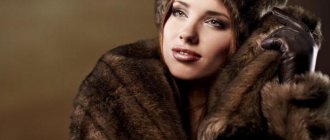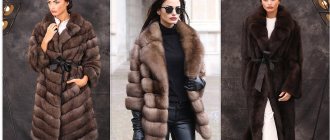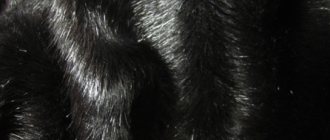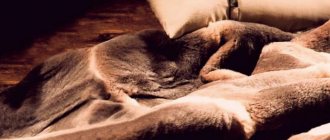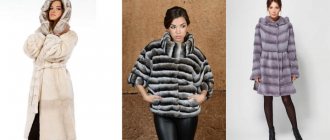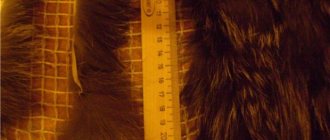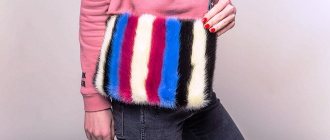Thermal characteristics of fur
[ads1]
The ability of a fur coat to warm its owner depends on the length, thickness of the fur and the elasticity of the hair. Thermal protective properties largely depend on the number of air bubbles inside and between the hairs, and the looseness of the inner layer. Often the mesh is stretched, trying to reduce the weight of the fur coat. At the same time, the gaps between the hairs increase, the air gap decreases, and the thermal properties of the product decrease. Based on their heat-protective properties, animal skins are divided as follows:
- The skins of gopher, rabbit, ermine, and goat are recognized as the coldest.
- Mink, chinchilla, beaver, and arctic fox have average thermal characteristics.
- The warmest fur is found in fox, sable, wolf and muton.
The thermal qualities of fur largely depend on the thickness of the hair and down. The density of the down can be easily checked by blowing on the fur. The hair should be long and shiny. The longer the hair, the warmer the product. In foxes, raccoons, wolverines, and arctic foxes, the hair length reaches 40 mm, in muskrats and sables - 25-40 mm, in minks - about 25 mm.
The Arctic fox is able to withstand temperatures down to -60 degrees thanks to its long hair. Therefore, arctic fox fur coats can warm their owner even in very frosty winters. This fur is valued for its softness and beauty. Blue fox fur coats look especially luxurious and are expensive.
It is important to consider for what purpose you are purchasing a fur coat. If you plan to spend most of your time outdoors in humid air, then you should pay attention to products made from the fur of animals that live in water: otter, nutria, beaver. [ads3]
The skins of sable, arctic fox, and fox are considered the softest.
As an indicator of your own prestige, you can choose a chinchilla or ermine fur coat. But you need to remember that such products are often sewn on a lining without insulation. In cold weather there is a risk of freezing.
Sheared fur also cannot boast of its heat-protective properties. Models made from whole fur provide better warmth in cold weather than counterparts made from individual skins. The warmest fur coats are considered to be made from reindeer, muton, fox and sable.
Interestingly, the fur of males is much warmer than that of females. True, it is quite difficult to verify this in practice.
Let's choose who is warmer?
- Mink and mouton. A mink coat has become an indicator of the status of its owner. It looks rich and is very expensive. But the thermal properties of a mouton are significantly higher than that of a mink. Mouton is a specially treated sheepskin. A product made from it has the ability to maintain optimal temperature. Previously, the mouton was not held in high esteem due to its unattractive appearance. Nowadays, mouton fur coats look no worse than mink ones, thanks to painting and special processing. Modern technologies make it possible to produce models from mouton of different textures, shades and styles. Mouton is characterized by durability, high thermal characteristics, resistance to dampness and easy care.
- Mink and beaver. The fur of both animals is beautiful, durable and practical. But the beaver undoubtedly wins in terms of heat retention.
- Fox. Fox coats are rightfully considered the warmest due to their long, thick hair. Plus, they are bright. And models made from silver fox, whose black and silver fur is soft and beautiful, are classified as elite outerwear.
[ads5]
Tips for choosing
Every girl is stunned by the variety that is presented in salons today. Experts advise going for your coveted purchase exclusively to trusted salons that have been on the market for a long time. Usually they keep the brand and do not push low-quality products to customers.
Before trying on, you need to hold the fur coat in your hands and shake it. If it makes a hard, rattling sound, it is better to refuse to buy it. This indicates poor-quality fur production. You should also conduct other experiments - crumple the material and run your palm against the grain. The fibers should not break or fall out, and the crumpled material should quickly recover and remain even and smooth.
Wearability of a fur coat
The cost of fur products does not allow most women to change them every season. Therefore, it is important that the chosen fur coat is practical and serves its owner for as long as possible, while maintaining an attractive appearance.
Wearability is one of the properties of fur. It depends on several factors:
- hair wear resistance;
- bond strength between leather tissue and hair;
- wear resistance of leather fabric;
- dyeing;
- dressing;
- storage conditions.
The durability of otter fur is considered to be 100%. This is 20 seasons - the largest figure. The wearability of other types of fur is calculated in relation to this figure. Based on wear data, you can roughly calculate how many seasons a fur coat will last. Fur manufacturers provide the following data:
The durability of a fur product is largely determined not only by the natural properties of the skin, but also by the skill of the manufacturer and the processing method. This figure will be higher if the product has “winter” fur. It has a higher density and thick down. In animals during the molting period, the strength of the bond between the flesh and the hair decreases, so such skins are of low quality.
Fur coloring reduces wearability by 10-20%, and cutting, on the contrary, increases wearability by 20-40%. Therefore, long-haired fur is sometimes trimmed to prevent breakage and matting. But sheared fur of ermine, rabbit, and gopher warms worse.
From mink fur | Average price 130 thousand rubles
In 9th place was a mink fur coat . It should be taken into account that the thermal insulation properties of fur depend on the place where the animal is bred. Southern mink fur is light and has a fine undercoat. A fur coat made of such fur will not warm you any better than a fur coat made from a rabbit. Northern mink fur is heavy, with a thick and dense undercoat. Mink coats are highly wear-resistant and, if stored properly, will last at least 20 seasons. Mink fur has an even pile with high plasticity. The beauty of mink fur has made products made from this material extremely popular among women.
The average cost of a mink coat is 130 thousand rubles.
How to choose a fur coat that will last for many years?
There are signs of the quality of a fur product that you need to pay attention to when purchasing.
- Kind of animal. When purchasing an inexpensive rabbit or hare fur coat, be prepared that it will last no more than 3 seasons if treated well. It will quickly lose its original appearance. For this reason, hats, fur coats, and vests for children are made from the skins of rabbits, squirrels, and hare. Children grow quickly; they do not need the product to remain durable for several years. But at the same time, such things have good thermal qualities and low cost.
- Treatment. The fur of a quality fur coat is thick, without bald spots, shiny, and elastic. The mezdra is white. It should not rattle when shaken. It is worth paying attention to how the lining is sewn. If it is not sewn tightly, this indicates that the manufacturer is confident about the quality of the product and gives the buyer the opportunity to evaluate the finishing of the skin from the inside.
- Sewing. Fur coats sewn “unfolded” and whole are allowed. It all depends on what kind of fur the product is made of. If the animal has thick flesh (beaver, raccoon, nutria), then it is usually sewn “unfolded”. In this case, the fur coat will fit better and will not look like a sheath. And if the fur is thin (mink), then a fur coat sewn “in loose” can make plump ladies look slimmer. In any case, tailoring depends on the style, length and even color of the product. Pay attention to the quality of the seams. The fewer there are, the stronger the product.
- Fur dyeing. Fur dyeing can be done for different purposes. Often the manufacturer uses it to hide defects. For this, dark shades are usually used. But there is fur that needs to be dyed, since in its original form it does not look very attractive. For example, nutria. Fur is now dyed and tinted using high-tech dyes that do not affect the quality of the product. Therefore, if you really want to buy a fur coat made of purple fox fur, then you should not be afraid. To check whether colored fur will not get dirty when worn, you need to wrap a few hairs in a handkerchief and rub it a little. If there are no traces of paint on the scarf, then you don’t have to worry about the quality of the dyeing.
- Dressing. To check the quality of the workmanship, you need to crumple any part of the fur product. It should immediately return to its original shape. To check the quality of the fur, stroke it against the grain. The down should be clearly visible, thick, and the hair should be elastic. The fur should not separate from the skin, leaving hair in the hand.
[ads7]
Some clever manufacturers manage to replace expensive fur with cheaper ones. So, instead of sable they can sell marten, instead of nutria - beaver and even rabbit - instead of mink. Mink and rabbit fur differ in stiffness. A rabbit's spine is much softer than a mink's. [ads2] When choosing a fur coat, you need to proceed from the possibilities of your own income and the purpose of the purchase. If you need it in order to emphasize your solidity, then you can purchase a lightweight model made of mink or arctic fox. But if you plan to spend a lot of time in the cold, then you should think about purchasing a fur coat made of mouton, fox, or wolf. When buying an inexpensive fur coat made from a rabbit, gopher or hare, you need to be prepared for the fact that it will not last long. But this option is suitable for those who like to regularly change their wardrobe. If you do not have the opportunity to often buy such expensive things, perhaps you should think about purchasing a more expensive but high-quality model. Therefore, before making such an expensive purchase, you need to carefully weigh everything, think it over and choose the appropriate option in terms of means and application.
2 comments on “Which fur coat is the warmest and most practical?”
- Svetlana:
11/25/2020 at 11:52 am
I assumed that a mouton could be one of the warmest furs, my grandmother had a fur coat made of a mouton, the color “leopard” - it looked amazing. She always said that she was always warm. But about the fox, I didn’t think it was so warm. I like mink fur, although it has average thermal characteristics, but it lasts a long time and retains its appearance. Of course, I would like a sable fur coat, but the prices...
Answer
- Natalia:
01/30/2021 at 16:20
I myself really like the arctic fox fur coat, it’s warm and has shown itself to be excellent when worn. When my husband and I bought it, I chose it simply because I liked it - the color, the shape, the quality of the fur (my grandfather was a furrier and I understand a little about this). I heard that animal fur retains heat in different ways, but I never paid attention to it. Now many people buy a fur coat just to show that they can afford it.
Answer
Quality and durability of fur from sable to rabbit
Speaking of fur, we can safely say that it will never go out of fashion. Fur is not only present in all the world's Fashion Weeks, it penetrates everywhere. These are not only floor-length fur coats, these are all kinds of capes and trims.
When choosing a fur coat, coat, vest, cape, you probably think not only about fashion and beauty, but also about how long you will have to wear it and how warm it will be. After all, our country is northern, there are quite a few cold days. But don’t be upset that you don’t live in Cuba or Thailand. The beauty of the North is no less attractive and gives you the opportunity to transform into snow queens, snow maidens, and Russian beauties.
And so it's all about fur. Which ones are the best and warmest?
We have the richest fur base in Russia. On the vast territory of our country there are more than 100 species of fur-bearing animals and animals. By the way, fur skins are skins obtained from animals that are hunted or bred on animal farms, and fur skins are skins obtained from domestic and farm animals.
All fur skins are divided into two types - winter and spring. Winter skins are the skins of animals that have the best fur in winter and do not hibernate. These are the skins of mink, squirrel, fox, marten, sable, hare, etc. This species also includes animals that have better hair in winter - rabbits, dogs, cats. Spring species are the skins of animals that hibernate in winter and have the best skin in spring, summer and autumn, except during molting. These are marmot, gopher, muskrat, nutria, etc. Spring species include the skins of domestic animals: sheep, goats, calves, deer, etc. When preparing skins, the time of molting of the animal should be taken into account.
Skins and fur, which animals and animals are considered the best? There is no clear answer. Some people like the sparkling shine of sable, some like a warm, good-quality sheepskin coat, and some like the beauty of a silver fox. But still. The quality of the fur of animals and animals depends on many factors: on the geographical habitat, on seasonal and age-related variability, on the living conditions of the animal, and it is also known that in different areas of the skin of an animal or animal the thickness of the hair is not the same, etc.
The quality of fur is assessed not only by its beauty - thickness, softness, silkiness, color, shine, but also by wear resistance and heat-protective properties. To what extent can fur stably retain its properties under various physical, chemical and mechanical influences, what are its heat-shielding properties - these are the questions that always concern us when purchasing a product. Wear resistance and heat-protective properties depend on many factors, from the structure of the hair to the time of preparation of the skin.
Based on experimental and laboratory observations, the following wear resistance of furs was established (in percent).
Kamchatka beaver 100 Otter 100 Wolverine 100 Seal 90 River beaver 90 Sable 80 Mink 70 Belek 70 Arctic fox 65 Foal 64 Karakul 60 Marten 60 Seal 55 Fox 50 Muskrat 45 Corsac 45 Lynx 40 Ferret 35 Squirrel 30 Marmot 27 Col onok 25 Ermine 25 Suslik- sandstone 22 Cat 17 Rabbit 12 Mole and gopher 10 Chipmunk 8 Hamster 6 Hare 5
As you can see, here are not all 100 or more species of animals that live on the territory of Russia. But using this table you can find your bearings about the wear resistance of those furs and skins that interest you. For example, this list does not mention sheepskin.
Sheepskin is fur from an adult animal. Naturally, it is rougher, but less beautiful than broadtail. Which one is more wear-resistant? Sheepskin, of course. Which one is more expensive? - Karakulcha. Because he is very beautiful and in demand. And that’s not all it’s all about. But while we are talking about wear resistance, all other questions about broadtail are a different conversation. This is how you can use this table on the wear resistance of fur and skins.
Now the heat-protective properties of fur
The heat-protective properties of furs and skins depend on the height, thickness and elasticity of the hair. This is something that we can determine visually or by touch. There is another important property that is more difficult to determine. This is the stability of the layer of air enclosed in the hair. If the fur is elastic, the air enclosed in the hair becomes motionless. This determines good heat-shielding properties.
When we wear our favorite fur coat for a long time, year after year, the height of the fur decreases, it shrinks, and the fur coat does not warm as much as before. Its heat-shielding properties decrease as the thickness of the air layer decreases. Fur products made with the leather side out provide better warmth, while those made with the fur side warm worse. So our Russian sheepskin coats, fur coats and fur coats were sewn with the fur inside. It's much warmer. At the same time, the furs most often consumed were: squirrels, hare, fox, marten, sable, beaver, and ermine.
And in ancient manuscripts there is some kind of guard fur - a guard fur coat. What kind of animal is this guard? You guessed it. This is a dog. Of course, it’s not a princely or royal thing to wear a guard’s fur coat. It was worn by ordinary people, and it warmed no worse than sable. The leather side, that is, the top of the fur coat, was decorated with fabric - velvet, satin, taffeta, brocade, cloth, and in addition with lace, stripes, pearls and other Russian embroidery.
According to scientific research on the heat-shielding properties of fur, the order of furs and skins can be given depending on thermal resistance at an air flow speed of 5 m/s. The listing of furs and skins is in descending order of heat-protective properties.
Blue Arctic fox Northern deer Red fox White hare Sheared sheepskin Sable Long-haired rabbit Yakut squirrel Sea seal White muskrat Plucked rabbit Large-curl merlushka Goat Small-curl merlushka Short-haired rabbit Mole Artificial astrakhan fur
Now that you know so much about fur, consider whether you're more interested in warmth, durability, or beauty. If you are a girl who doesn’t like to wear the same thing for a long time for years, then there is no point in spending money on an expensive fur coat that you will change next year anyway. So, according to these tables, you can choose it so that it is both beautiful and inexpensive, but warm. And from expensive furs you can buy a collar or scarf, for example, from sable or mink fur, or maybe individual fluffy details. For example, fur bolero, capes, scarves, cuffs, muffs, boas, stoles, which go well not only with a coat, but also with a classic sheath dress, a floor-length evening dress, a cardigan and even a turtleneck.

